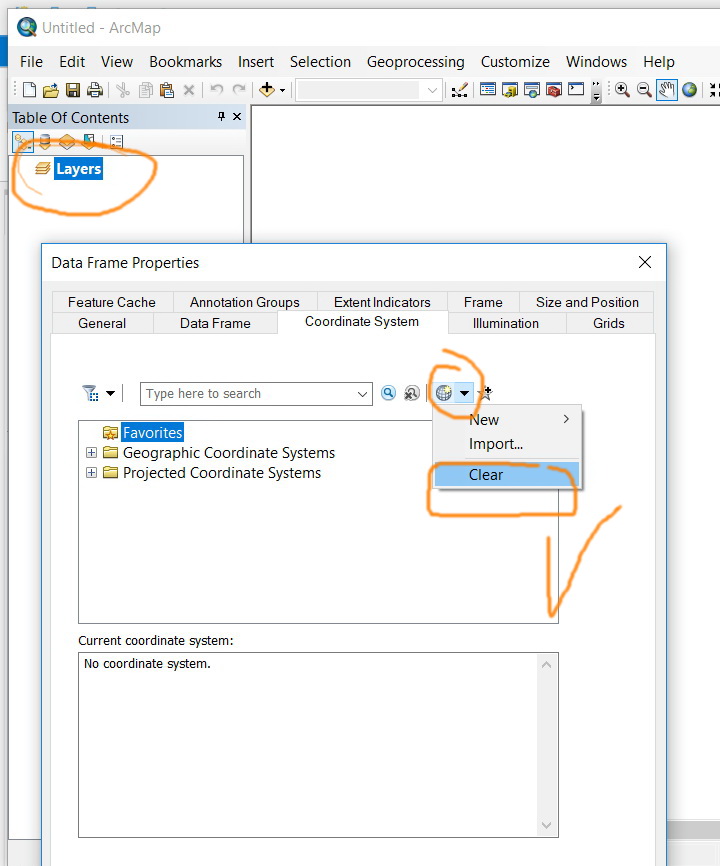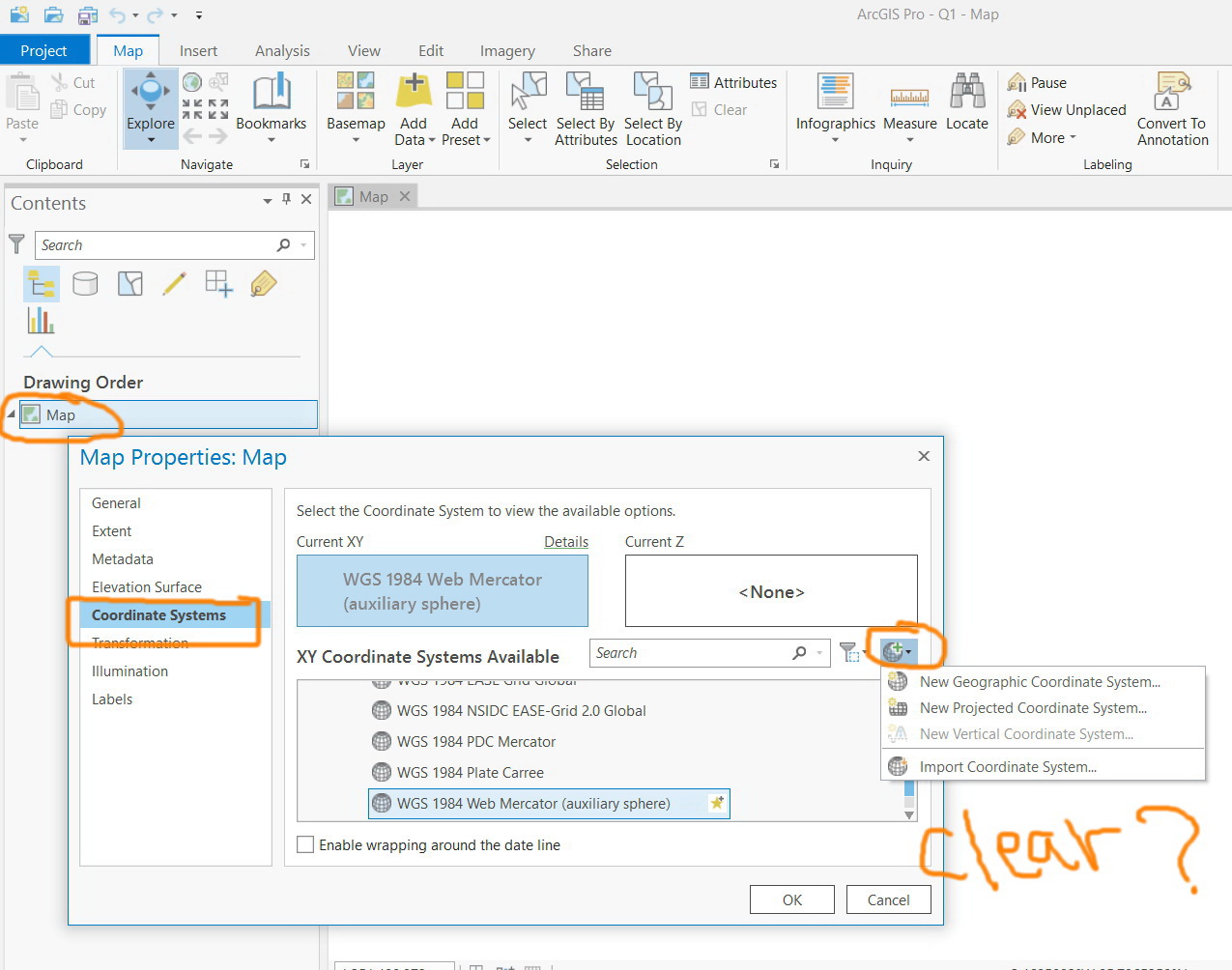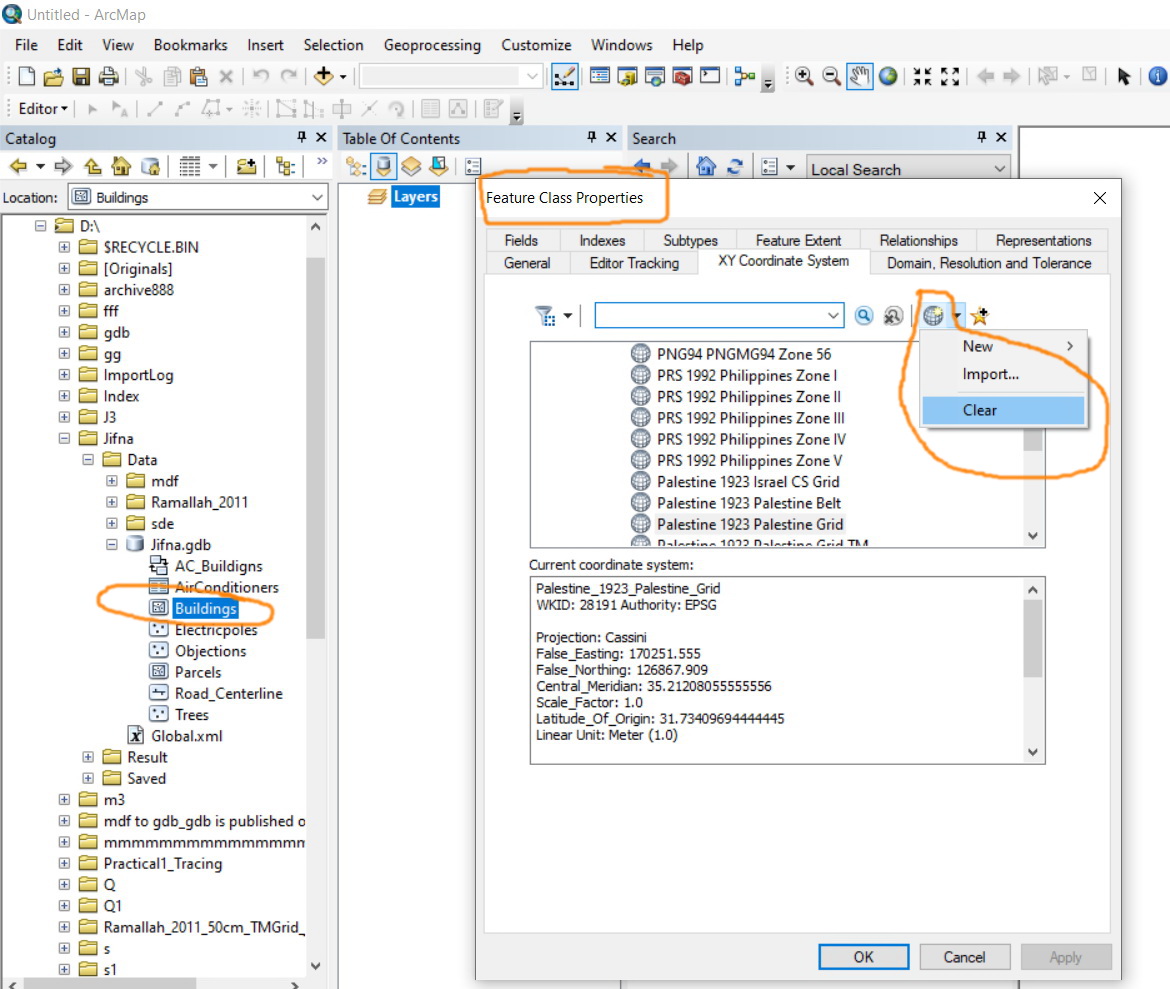- Home
- :
- All Communities
- :
- Products
- :
- ArcGIS Pro
- :
- ArcGIS Pro Questions
- :
- Re: How to “clear” the coordinate system of the “M...
- Subscribe to RSS Feed
- Mark Topic as New
- Mark Topic as Read
- Float this Topic for Current User
- Bookmark
- Subscribe
- Mute
- Printer Friendly Page
How to “clear” the coordinate system of the “Map” to get it to “unknown” in ArcGIS Pro,
- Mark as New
- Bookmark
- Subscribe
- Mute
- Subscribe to RSS Feed
- Permalink
How to “clear” the coordinate system of the “Map” to get it to “unknown” in ArcGIS Pro,
For example, in ArcMap, the clear option is available and one can set the “data frame” to unknown. I couldn’t figure out how to “clear” the coordinate system of the “Map” to get it to “unknown” in ArcGIS Pro as this option is not there


Jamal Numan
Geomolg Geoportal for Spatial Information
Ramallah, West Bank, Palestine
- Mark as New
- Bookmark
- Subscribe
- Mute
- Subscribe to RSS Feed
- Permalink
Great to see you commenting here Ms Maher. Margaret Maher
I ran into a related issue yesterday, a file downloaded from the Pierce County (WA) Open GeoSpatial Data Portal Pierce County WA Open GeoSpatial Data Portal (v2.1) that was NAD83_HARN_Washington_South_ftUS. When I tried to Project to NAD_1983_UTM_Zone_10N and/or NAD_1983_HARN_StatePlane_Washington_South_FIPS_4602_Feet, I could not get a Geographic Transformation to work (there was no dropdown to use. (using 10.7.1 ArcMap btw) thus, tried to Project without one, and we know what happened then... I didn't 'Line up Data in ArcGIS' :-).
I've spoken with Pierce County about this, who stated: (and arguably, this information belongs in a different discussion, but it is semi-related...
"Shapefiles have downloaded from Open Data in NAD83_HARN_Washington_South_ftUS projection since ESRI enabled native projections (2015/2016??). "
and:
"In this case, you may be the first person to discover the problem with re-projecting NAD83_HARN_Washington_South_ftUS using ArcMap."
"I would be curious if shapefiles can be re-projected using open source GIS software. It might be a good project for a student. QGIS is the one I would try first. "
For the record.
I'm still voting for Esri to allow the 'clearing of the projection' in ArcPro.
Let the user decide? 🙂
- Mark as New
- Bookmark
- Subscribe
- Mute
- Subscribe to RSS Feed
- Permalink
Is there any chance to the have the “clear” command implemented in 2.5?


Jamal Numan
Geomolg Geoportal for Spatial Information
Ramallah, West Bank, Palestine
- Mark as New
- Bookmark
- Subscribe
- Mute
- Subscribe to RSS Feed
- Permalink
Hi Jamal,
No, because we're in the process of finalizing 2.5. It is on my list to discuss with the map team for the next release--but only to discuss it! NO guarantees.
Melita
- Mark as New
- Bookmark
- Subscribe
- Mute
- Subscribe to RSS Feed
- Permalink
Thanks for considering it!
- Mark as New
- Bookmark
- Subscribe
- Mute
- Subscribe to RSS Feed
- Permalink
Since this subject involves my areas of specialization in Support Services, I have to wade in. One of the very common workflows Esri customers are involved with is bringing in CAD data - AutoCAD and Microstation - and overlaying or converting these data to GIS formats using tools available in Esri software or extensions.
In many cases, CAD data is created in a known coordinate system that has a WKID associated with it, and it that is the case, that's great. However, a lot of CAD data is created in an undefined local coordinate system, that has no relation to any known projection. In order to integrate these data into the GIS, the alignment issue has to be resolved one way or another. Here are the available methods.
1] Georeference the CAD file in Esri software (ArcMap or Pro). I do not advise customers to use this method, since georeferencing survey grade data changes the lengths of lines, and alters the angular relationship between those lines. Picture this with parcel data in a CAD file.
2] Create a custom projection file to align the data with reference data in a known projection. The custom projection file tells the software the location to draw the data on screen, without altering the geometry of the features. Chapters 4, 5 and 6 of my book "Lining Up Data in ArcGIS: a guide to map projections (Third Edition, Esri Press 2018) outlines this process in detail.
The other common occurrence with CAD data is that the projection is defined, but defined incorrectly - i.e. data created in a local coordinates then defined as State Plane for example.
Allowing the user to "clear" the projection from the data frame, either in ArcMap or Pro, is the single quickest and easiest method to determine if two data layers are actually projected to the same coordinate system. Do the coordinate extents of the data match, so that the data line up in an data frame with no projection assigned? If so, they are in the same coordinate system, regardless of the projection definition, which in any given case may be right or wrong.
In an ideal world, this would not be necessary, but we do not live, work, and do our GIS projects in an ideal world, so we need all the tricks available in order to make things work as efficiently as possible.
- Mark as New
- Bookmark
- Subscribe
- Mute
- Subscribe to RSS Feed
- Permalink
Having a similar issue in ArcGIS Pro 2.5. If I start a new map, with no basemap, the default coordinate system for the map is WGS84 Web Mercator. If I then add a DEM with defined coordinate system NAD 27 UTM 18N I get a warning that no transformations exist and that data may not line up. If I check the coordinate system associated with the map after adding the DEM it is set at NAD 27 18N. If I then remove the DEM from the contents pane, the blank map retains the NAD 27 UTM 18 N coordinate system, as expected, BUT if I re-add the DEM again, I get the same warning that no transformation exists, which suggest that the map is retaining the WGS84 Web Mercator projection even though it is not displayed.
If I start a new map and before adding any data change the coordinate system to NAD27 UTM18N and then add the NAD 27 UTM18N DEM I get the same "no transformation available" warning.
However, if I start a new map, and before adding any data, change the coordinate system to WGS84 UTM 18N and then bring in the NAD27 UTM 18N DEM, ArcGIS Pro happily transforms the coordinate system and displays a dialog box that a transformation was applied. Checking the Transformation in properties it shows a NAD27 to NAD83 NADCON +WGS 84 to NAD 83 transformation was used.
Any thought why ArcGIS Pro is unable to transform from the default WGS84 Web Mercator projection to NAD 27 UTM 18N, or why when the new map has NAD 27 UTM 18 N as the defined coordinate system, it still gives a warning of no transformation being available when one should not even be needed.
Thanks,
Dave
- Mark as New
- Bookmark
- Subscribe
- Mute
- Subscribe to RSS Feed
- Permalink
Hi Dave,
Is there any chance I can get the DEM for testing? I haven't heard of your issue. If it's possible, and the file's not too large, you can send it to mkennedy at esri dot com.
Melita
- Mark as New
- Bookmark
- Subscribe
- Mute
- Subscribe to RSS Feed
- Permalink
Melita,
I think that the issue was a result of corrupted metadata associated with the DEM. I downloaded a “clean” copy and did not have the issue with the new dataset.
I have run across another issue with ArcGIS Pro that you might have an idea about. If I load the Continents file from the Portal it opens in a new ArcGIS Pro map but the outline of continents comes in set at 100 pixels which completely covers the continent shapes completely. With Symbology I can easily reduce the outline to 1 pixel which brings the map back to looking like it should. Question is, why the outline defaults to 100 pixels in the first place?
Thanks,
Dave
Dave Tewksbury
FAA Certified UAS Pilot
GIS and Technical Support
Dept. of Geosciences
Hamilton College
Clinton, NY. USA
- Mark as New
- Bookmark
- Subscribe
- Mute
- Subscribe to RSS Feed
- Permalink
Hello Dave,
I saw your message to Melita Kennedy, and default symbology for data from ArcGIS Online that is brought into ArcGIS Pro is outside her wheelhouse. The issue you describe of outlines for the continents that are so thick that they obliterate the shape of the data sounds like a bug to me. If you would, please have a case created with Esri Support, so that we can investigate and log a bug in the system if needed.
Have a great day and thank you.
Margaret Maher
- Mark as New
- Bookmark
- Subscribe
- Mute
- Subscribe to RSS Feed
- Permalink
Margaret,
Will do.
Thanks,
Dave